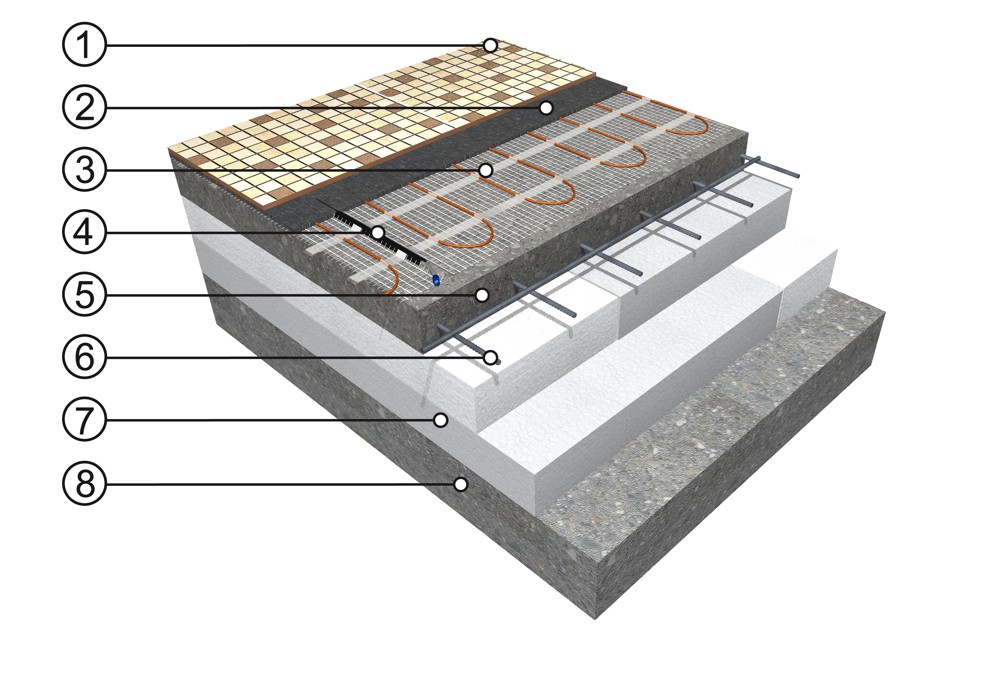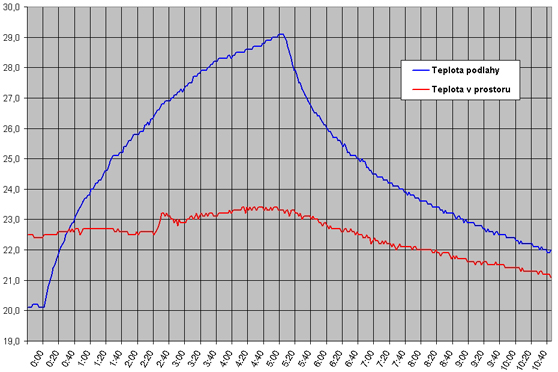
Speed measurement of floor heating without insulation and with F-BOARD insulation panels
ECOFLOOR systems (heating cables or mats) can be used as primary heating or just as comfort heating for the flooring - most commonly in bathrooms. In this second case, where the room is heated by another heat source (e.g., hot water radiator) and the electric heating mat serves the function of a comfort warm floor, an important factor is the time needed to warm up the flooring. The system operates in relatively short time periods (about 1 - 2 hours in the morning and evening) and it is required to heat the flooring in the shortest possible time. On the contrary, heat accumulation and long cooling of the floor is unnecessary and undesirable here. The ramp-up speed can of course be influenced by the type of the system and only direct heating systems should be used for supplementary heating (see image).
 |
| 1 - surface layer (ceramic tiles) 2 - flexible adhesive 3 - ECOFLOOR heating mat 4 - floor (limiting) probe in a protective tube (so-called goose neck) 5 - supporting concrete floating slab 6 - steel reinforcement (so-called Kari grid) 7 - thermal insulation (extruded polystyrene) 8 - substrate (load-bearing structure) |
However, even the use of a direct heating system is not a guarantee of sufficiently fast warming of the floor. The behavior of the floor depends on its overall composition, and if there is no thermal insulation in the construction, the floor can take several hours to heat up. This problem is particularly perceptible in renovations, as older structures usually lack any insulation and it is challenging and quite expensive to install an additional 6 cm of polystyrene. This means either demolishing about 10 cm of flooring to create space for insulation and a new floor or raising the floor by those 10 cm. And that is often technically impossible.
Nevertheless, there is a technically and financially feasible solution - the installation of additional F-BOARD insulation directly under the ECOFLOOR heating mat. The insulation increases the thermal resistance of the construction under the heating mat and ensures that heat is directed primarily into the flooring rather than into the underlying construction. The insulation is sold in thicknesses of 6 and 10 mm. When using F-BOARD 6 mm, the thickness of the entire new construction is only 2.5 cm including the heating mat and new tiles.
The significance of this insulation is demonstrated in three specific applications where temperature ramp measurements of the floor have been carried out. In all three cases, it involves the installation of a heating mat with a power of 160W/m2 directly in the adhesive under the tiles.
Bathroom in an apartment building
The apartment with the bathroom is located on the 2nd floor of an apartment building in Jeseník. The building was constructed in 1908 and is a massive structure made of solid burnt bricks, with external constructions 80 cm thick. Like the outer walls, the ceiling and floor structures are also massive. The beam ceiling has a cladding of boards, with a brick floor of 4 cm thick on the boards, complemented by a concrete floor of 4 cm thick in the bathroom. The house features very good thermal properties and an ideal humidity microclimate. The apartment is heated by a hot water system, and a heating mat was installed in the adhesive under the tiles in the bathroom, which was intended to serve as comfort heating for the floor. There is no additional insulation between the heating mat and the construction of the floor. Below the bathroom is a heated apartment of another tenant.
As shown in the illustrated graph, the floor warmed from 20°C to 28°C in 3.5 hours, reaching 29°C after a full 5 hours. After 5 hours of operation, the heating mat was turned off and a very gradual cooling of the floor followed. The system behaves unequivocally as an accumulator - this is due to the 8 cm layer of construction (4 cm concrete + 4 cm brick cladding) under the heating mat.
 |
Since it was intended to be only supplementary comfort heating, unfortunately, the entire system can essentially be labeled as non-functional. This issue could have been easily avoided by installing additional insulation, as will be seen in the following application.
Bathroom in a family house
During the renovation of the bathroom in the family house, the user requested the installation of an electric heating mat. Here too, it serves only as supplementary comfort heating, as the heating of the bathroom is ensured by a hot water radiator. The bathroom is located on the ground floor, with a cold unheated basement below. Since this is an older building, there is no (!) thermal insulation in the floor. The floor consists of an 8 cm thick concrete slab (2x 4cm) with waterproofing. A thermal insulation CLIMAPOR-POLYPLAN of 2 mm was laid on the prepared floor, followed by the heating mat and new tiling. From the illustrated graph, it is evident that despite the lack of any thermal insulation in the floor construction except for the 2 mm POLYPLAN and the unheated room below the bathroom having an average temperature of 5-8°C, the system operates very well and the floor heated up in just 26 minutes.
 |
The cycling temperatures in the upper part of the graph (28-29°C) are due to the thermostat, which alternately turned the heating mat on and off after reaching the desired floor temperature. Also, the cooling of the floor is significantly faster than in the first case because the CLIMAPOR-POLYPLAN insulation prevented unnecessary heat accumulation into the concrete floor.
Floor with F-BOARD insulation
In the testing room of Fenix Jeseník, a floor sample was created that structurally corresponds to a renovation where the new floor is laid on the original tiling. On the existing ceramic tile (laid on a concrete substrate without thermal insulation, the concrete is placed on natural soil) the F-BOARD 6mm insulation was fixed with adhesive, followed by a 160W/m2 heating mat and tiling. In the following graph, it is noteworthy that the temperature in the testing room was around only 20°C compared to the bathrooms in the two above cases.
 |
If we compare the temperature ramp graph in the testing room with the floor in the bathroom of the family house where the CLIMAPOR-POLYPLAN insulation was installed, an increase in the floor temperature from 22°C to 28°C occurred in 24 minutes, which is "only" two minutes earlier. However, this warming occurred at a significantly lower space temperature, which has a significant impact on the cooling of the floor and therefore on the speed of its heating. Thanks to the larger thickness of the F-BOARD insulation, better dynamics of the system are achieved. The insulation with F-BOARD boards has other advantages over the CLIMAPOR-POLYPLAN insulation - the insulation is made in boards and installation is very easy. CLIMAPOR-POLYPLAN comes in rolls and during installation, the so-called material memory effect is manifested - POLYPLAN tends to create "bridges" on the floor. Furthermore, F-BOARD is additionally coated on both sides with a layer of adhesive reinforced with fiberglass. This ensures excellent adhesion of the individual layers and also greater mechanical load capacity of the floor. When using the recommended adhesives and following the technological procedure, the F-BOARD insulation also functions as waterproofing, which is a huge advantage, for example, in renovations or wooden constructions.
Conclusion
For easier comparison, all three applications were combined into one graph to compare the heating ramp speed directly over a time span of 2 hours. The curves of the individual applications are in the same color, the curves of the floor temperatures are bold, the space temperature curves thin.
.jpg) |
In conclusion, it can be stated that additional insulation in systems that serve the function of occasional comfort heating of flooring certainly has its significance and this initial investment will pay off numerous times in the form of flexible and energy-efficient operation.
The English translation is powered by AI tool. Switch to Czech to view the original text source.
0 comments
add comment












